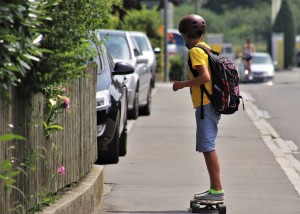BACK TO SCHOOL AND BACKPACK SAFETY
Backpacks come in all sizes, colors, fabrics, and shapes and help kids of all ages express their own personal sense of style. And when used properly, they’re incredibly handy.
When worn correctly, the weight in a backpack is evenly distributed across the body, and shoulder and neck injuries are less common than if someone carried a briefcase or purse.
As practical as backpacks are, though, they can strain muscles and joints and may cause back pain if they’re too heavy or are used incorrectly.
Problems Backpacks Can Pose
It is recommended that kids carry no more than 10% to 15% of their body weight in their packs. But many carry a lot more than that. When a heavy backpack is incorrectly placed on the shoulders, the weight’s force can pull a child backward. To compensate, the child might bend forward at the hips or arch the back. This can make the spine compress unnaturally, leading to shoulder, neck, and back pain.
Kids who wear their backpacks over just one shoulder — as many do, because they think it looks better or just feels easier — may end up leaning to one side to offset the extra weight. They might develop lower and upper back pain and strain their shoulders and neck.
Finding a Safe Backpack
Look for the following to choose the right backpack:
- a lightweight pack: get one that doesn’t add a lot of weight to your child’s load; for example, leather packs look cool, but they weigh more than canvas backpacks
- two wide, padded shoulder straps: straps that are too narrow can dig into shoulders
- a padded back: it not only provides increased comfort, but also protects kids from being poked by sharp objects or edges (pencils, rulers, notebooks, etc.) inside the pack
- a waist belt: this helps to distribute the weight more evenly across the body
- multiple compartments: to help distribute the weight throughout the pack
Using Backpacks Wisely
To help kids prevent injury when using a backpack:
- Lighten the load. No matter how well-designed the backpack, less weight is always better. Use the bathroom scale to check that a pack isn’t over 10% to 15% of your child’s body weight (for example, the backpack of a child who weighs 80 pounds shouldn’t weigh more than 8 to 12 pounds).
- Use and pick up the backpack properly. Make sure kids use both shoulder straps. Also tighten the straps enough for the backpack to fit closely to the body. The pack should rest evenly in the middle of the back and not sag down to the buttocks.
What Kids Can Do
A lot of the responsibility for packing lightly — and safely — rests with kids:
- Encourage kids to use their locker or desk often throughout the day instead of carrying the entire day’s worth of books in the backpack.
- Make sure kids don’t tote unnecessary items — laptops, cellphones, and video games can add extra pounds to a pack.
- Encourage kids to bring home only the books needed for homework or studying each night.
- Picking up the backpack the right way can help kids avoid back injuries. As with any heavy weight, they should bend at the knees and grab the pack with both hands when lifting a backpack to the shoulders.
- Use all of the backpack’s compartments, putting heavier items, such as textbooks, closest to the center of the back.
What You Can Do
Involving other parents and your child’s school in solving students’ backpack burdens might help to lessen kids’ loads. Some ways the school can get involved include:
- giving students more time between classes to use lockers
- using paperback books
- adding school education programs about safe backpack use
- putting some curriculum on the school’s website, when possible





No comments yet.